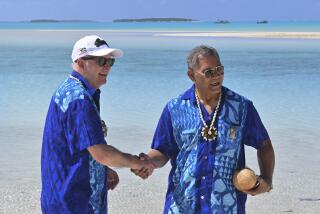Mining Puts Island on Road to Nowhere
- Share via
SYDNEY, Australia — The tiny South Pacific nation of Nauru, one of the world’s smallest and richest countries, is seeking $2 billion from five former colonial powers to landscape the moonscape left by 81 years of phosphate mining.
Nauru, 2,480 miles north of Sydney, wants the money from Australia, Britain, Japan, New Zealand and West Germany, whom it blames for the devastation across the 8-square-mile island--about one-third of the size of New York’s Manhattan.
So far, it has heard from none of them.
“It’s an absurd idea,” said one Australian official. “It’s as if Australia and the others have already been judged guilty.”
With an annual per capita income of $21,400, the 4,500 Nauruans form one of the world’s richest nations. But two-thirds of the island is uninhabitable.
$100-Million-a-Year Industry
Phosphate, the fertilizer derived from centuries-old bird droppings, earns Nauru about $100 million a year. Since 1906, more than 100 million tons have been mined, turning most of the island into a lunar landscape of needle-like coral pinnacles as phosphate was dug around them.
For years, the government of President Hammer deRoburt has scouted the South Pacific and the Caribbean for a new island on which to resettle the population. Australia once offered an island off Queensland, but it refused DeRoburt’s demand for autonomy.
In February, Nauru ordered a three-man commission to study the country’s future. Chairman Christopher Weeramantray is expected to issue a report before the end of the year.
Imperial Germany ruled the island from 1888 until Australia occupied it in 1914. Japanese troops held it for three years during World War II. Australia, Britain and New Zealand then moved in as partners in the British Phosphate Commission until Nauru achieved independence in 1968.
Trust Established
Nauru, called Pleasant Island by early European settlers, continued mining phosphate. About 60% of exports go to Australia. New Zealand imports 15%, and the rest goes to the Philippines.
The 64-year-old DeRoburt tried to offset the hardship to come by establishing the Nauru Phosphate Trust, which reportedly has assets of $750 million in investments and real estate in Australia, Guam, Saipan, Western Samoa and the United States.
The idea is that when the deposits are exhausted, Nauruans will be able to live off the interest on investments.
As part of the investment program, Nauru started an international airline and shipping company. Neither has shown any promise.
Last year Air Nauru lost $18 million against total revenue of less than $5 million. The Nauru Pacific Line, which does not disclose its results, is believed to be losing even more than the airline.
DeRoburt discourages reporters from visiting and writing about his country, although he is eager to spread the word of his demand for $2 billion to resurface the island. Part of his plan is to ship topsoil to Nauru in the ships that arrive empty to carry away the phosphate.
“Australia should be addressing our needs,” he was quoted as saying recently in rare interview with an Australian correspondent.
“We are not all satisfied with their response, and they know it. They have claimed they have no responsibility. But they do, and that’s that.”
Cars Popular With Residents
Visitors say Naurans spend much of their time driving cars around the island’s ring road, which takes only about 20 minutes for one circuit.
Nauru became so dependant on phosphate that all traditional farming and fishing had ended and all foodstuffs and goods now are imported.
Traditional staples like fresh fish and tropical fruits have been replaced by canned meat, polished rice, white sugar and locally prepared Chinese food, visitors say.
More to Read
Sign up for Essential California
The most important California stories and recommendations in your inbox every morning.
You may occasionally receive promotional content from the Los Angeles Times.









